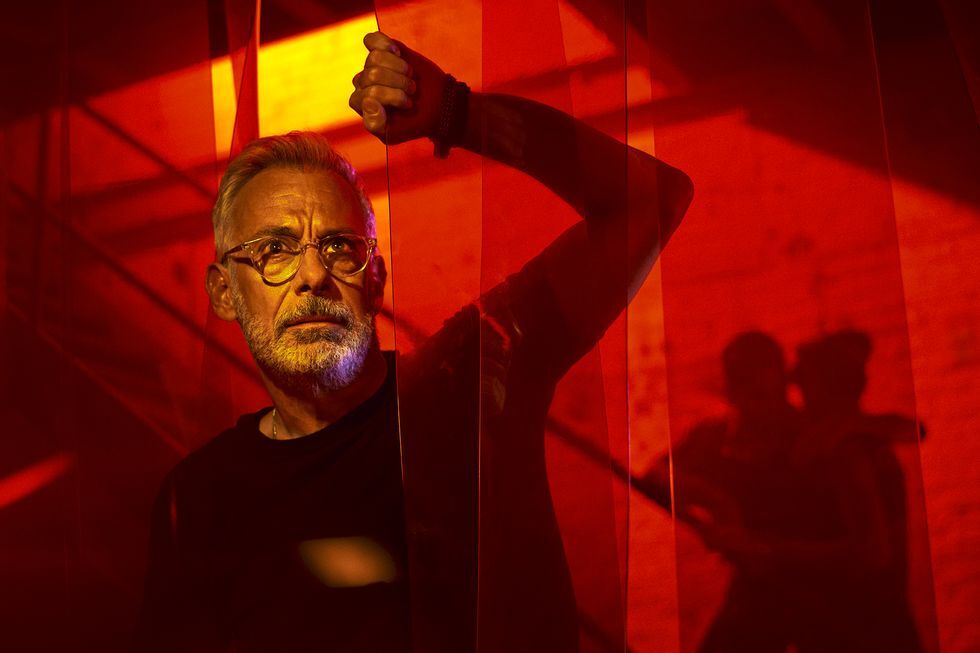American Horror Story’s eleventh season is a tableau of New York’s gay subcultures, thriving in its 1981, pre-AIDS glory. Its characters are male eye candy in jockstraps and stripy socks, daddies in leather straps and twinks out for a laugh. As Kal Penn’s cynical police commissioner summarizes, “That community? They come here for a reason. They come here to get lost, and that’s exactly what they do.” The style? A mood board of Mugler costume-fashion, Chrome Hearts leather jackets, Lagerfeld’s filled shoulder pads and Calvin Klein underwear billboards.
But its premise is that of an earlier and much more controversial gay masterpiece: Cruising.
Released in 1980 and directed by William Friedkin, Cruising is a serial-killer thriller of the best kind, with Al Pacino’s Detective Steve Burns going undercover in leather bars and deep into the moral abyss, and it was despised. Gay activists pre-emptively condemned it as homophobic, fearing the maker of The Exorcist had found his next demon in gay kink. They made such a racket during filming that most of the film’s dialogue had to be retroactively dubbed. Chilling, cynical and obliquely beautiful, Cruising is about the tragic fall of a man trying to resolve a mystery in a world of secrets, including himself, where justice will never be found. While AHS could never convey Friedkin’s bleak outlook, showrunner Ryan Murphy takes his dread, rich themes and narrative structure, stretches it out over five episodes (so far), and layers it with heavy doses of absurdism and camp.
There’s a leather-clad titan stalking the parks, dismembered body parts floating down the Hudson, a mysterious disease spreading, a second serial killer hiding in shadows and a conspiracy that ties them all together. It’s a dark metaphor for the imminent destruction of AIDS, which Murphy contrasts with gay subcultures depicted as lurid spectacles. But notably, the two leads are taken straight from Cruising. Arthur Bell was the gay Village Voice journalist whose reporting inspired Friedkin. AHS has a stand-in for him in the silver-haired Gina Barelli (played by Joe Montello), who writes for New York Native. His boyfriend is Russell Tovey’s Detective Patrick Read, though clean-cut and closeted (in contrast to Pacino’s tanned, sweaty, positively filthy Detective Burns), lives a life built atop a mound of secrets:
“I had to lie to everybody about it,” he tells Barelli.
“Why?” Barelli replies.
“I don’t know.”
“There’s nothing to be ashamed of!”
“Yeah, true. But it’s hotter when it feels like there is.”
Alongside the detective and journalist trying to find the killers through their professional means, we also have Adam Carpenter, played by Charles Carver, who visits a photography studio wearing blue jeans, a white waffle-knit singlet and red varsity jacket, carrying such a perfectly Americana jock innocence that you don’t know whether to drop to your knees or bend him over. He has a strained relationship with a photographer he fancies, which Murphy uses to explore the trade-offs of free love and monogamy. But, as with his other themes — namely, the link between threat and attraction, sex and death, submission and dominance, the dangerous ambivalence of authorities, and gay New York on the brink of AIDS — Murphy does it with a wink and a smirk. A character remarks, “If you wanted monogamy, you should have been born straight.” Another — a dark, mysterious man of influence, played by returning cast member Zachary Quinto: “I’m a collector, I like pretty things. You don’t?”
Though the plot isn’t always the focus, there’s still unnecessary, detracting fat. At one point, the journalist, Perelli, flickers through some photographs, stopping on one of famous drag-queen Marsha P. Johnson, whose role in gay rights has been posthumously overinflated. It’s meant to be a touching moment but feels forced and unnecessary. Sure, it explores big ideas, but it’s focused on its aesthetic and tone, which is camp with a dark edge — everything’s in service of the vibe, and AHS: NYC has a great vibe.
It’s Cruising with a hard-on, Grindr as a thriller and very much inspired by Tom of Finland, the pen name of Tom Laaksonen, a world-renowned erotic cartoonist (the greatest gay artist of the twentieth century, alongside David Hockney). His Übermensch caricature Kake (another leather-clad titan), with his bulging groin and charming smile, perverted the humorless hyper-masculinity of violent authoritarianism and turned it into a fetish item. With it, he underlined and mocked the inherent homoeroticism of fascists, but it was never primarily political. It was what Laaksonen found both erotic and deliciously fun. With Season 11 of AHS, Ryan Murphy has done the same.


















